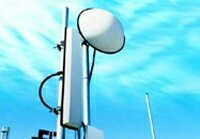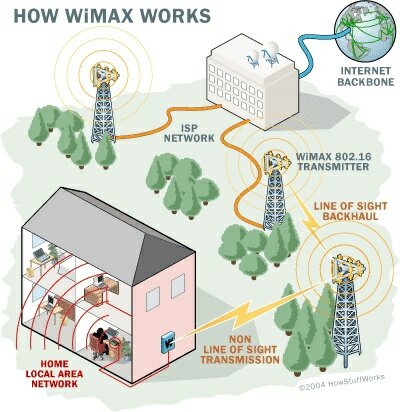WiMAX is an acronym that stands for Worldwide Interoperability for Microwave Access. WiMAX is a wireless metropolitan area network (MAN) technology that can connect IEEE 802.11 (Wi-Fi) hotspots with each other and to other parts of the Internet. It can provide a wireless alternative to cable and DSL for last mile (last km) broadband access. WiMAX is the wireless solution for the next step up in scale, the metropolitan area network (MAN). WiMax does not conflict with Wi-Fi but actually complements it. A WiMax system consists of two parts: A WiMax tower & A WiMax receiver. WiMAX has the potential to do to broadband Internet access what cell phones have done to phone access. Some cellular companies are also evaluating WiMAX as a means of increasing bandwidth for a variety of data-intensive applications. The purpose of this Paper is to highlight and assess the value of WiMAX as the right solution to:
- offers cheap voice calls and high speed internet
- ensures a boost for government security
- extend the currently limited coverage of public LAN (hotspots) to citywide coverage (hot zones) the same technology being usable at home and on the move,
- blanket metropolitan areas for mobile data-centric service delivery,
- offer fixed broadband access in urban and suburban areas where copper quality is poor or unbundling difficult,
- bridge the digital divide in low-density areas where technical and economic factors make broadband deployment very challenging.
In addition to these uses, this paper will highlight other potential applications, such as telephony or an effective point-to-multipoint backhauling solution for operators or enterprises
1. INTRODUCTION
WiMAX is an acronym that stands for Worldwide Interoperability for Microwave Access, a certification mark for products that pass conformity and interoperability tests for the IEEE 802.16 standards. Products that pass the conformity tests for WiMAX are capable of forming wireless connections between them to permit the carrying of internet packet data. It is similar to Wi-Fi in concept, but has certain improvements that are aimed at improving performance and should permit usage over much greater distances. the WiMAX forum, backed by industry leaders, will encourage the widespread adoption of broadband wireless access by establishing a brand for the technology and pushing.
2. TECHNICAL ADVANTAGES OVER WIFI
Because IEEE 802.16 networks use the same Logical Link Controller (standardized by IEEE 802.2) as other LANs and WANs, it can be both bridged and routed to them.
An important aspect of the IEEE 802.16 is that it defines a MAC layer that supports multiple physical layer (PHY) specifications. This is crucial to allow equipment makers to differentiate their offerings. This is also an important aspect of why WiMAX can be described as a “framework for the evolution of wireless broadband” rather than a static implementation of wireless technologies. Enhancements to current and new technologies and potentially new basic technologies incorporated into the PHY (physical layer) can be used. A converging trend is the use of multi-mode and multi-radio SoCs and system designs that are harmonized through the use of common MAC, system management, roaming, IMS and other levels of the system. WiMAX may be described as a bold attempt at forging many technologies to serve many needs across many spectrums.
The MAC is significantly different from that of Wi-Fi (and ethernet from which Wi-Fi is derived). In Wi-Fi, the MAC uses contention access—all subscriber stations wishing to pass data through an access point are competing for the AP’s attention on random basis. This can cause distant nodes from the AP to be repeatedly interrupted by less sensitive, closer nodes, greatly reducing their throughput. By contrast, the 802.16 MAC is a scheduling MAC where the subscriber station only has to compete once (for initial entry into the network). After that it is allocated a time slot by the base station. The time slot can enlarge and constrict, but it remains assigned to the subscriber station meaning that other subscribers are not supposed to use it but take their turn. This scheduling algorithm is stable under overload and oversubscription (unlike 802.11). It is also much more bandwidth efficient. The scheduling algorithm also allows the base station to control Quality of Service by balancing the assignments among the needs of the subscriber stations. A recent addition to the WiMAX standard is underway which will add full capability by enabling WiMAX nodes to simultaneously operate in “subscriber station” and “base station” mode. This will blur that initial distinction and allow for widespread adoption of WiMAX based mesh networks and promises widespread WiMAX adoption. The original WiMAX standard, IEEE 802.16, specifies WiMAX in the 10 to 66 GHz range. 802.16a added support for the 2 to 11 GHz range, of which most parts are already unlicensed internationally and only very few still require domestic licenses. Most business interest will probably be in the 802.16a standard, as opposed to licensed frequencies. The WiMAX specification improves upon many of the limitations of the Wi-Fi standard by providing increased bandwidth and stronger encryption. It also aims to provide connectivity between network endpoints without direct line of sight in some circumstances. The details of performance under non-line of sight (NLOS) circumstances are unclear as they have yet to be demonstrated. It is commonly considered that spectrum under 5-6 GHz is needed to provide reasonable NLOS performance and cost effectiveness for PtM (point to multi-point) deployments.
3. HOW WIMAX WORKS

In practical terms, WiMAX would operate similar to WiFi but at higher speeds, over greater distances and for a greater number of users. WiMAX could potentially erase the suburban and rural blackout areas that currently have no broadband Internet access because phone and cable companies have not yet run the necessary wires to those remote locations.
A WiMAX system consists of two parts:
A WiMAX tower, similar in concept to a cell-phone tower – A single WiMAX tower can provide coverage to a very large area — as big as 3,000 square miles (~8,000 square km). A WiMAX receiver – The receiver and antenna could be a small box or PCMCIA card, or they could be built into a laptop the way WiFi access is today.
A WiMAX tower station can connect directly to the Internet using a high-bandwidth, wired connection (for example, a T3 line). It can also connect to another WiMAX tower using a line-of-sight, microwave link. This connection to a second tower (often referred to as a backhaul), along with the ability of a single tower to cover up to 3,000 square miles, is what allows WiMAX to provide coverage to remote rural areas. What this points out is that WiMAX actually can provide two forms of wireless service:
There is the non-line-of-sight, WiFi sort of service, where a small antenna on your computer connects to the tower. In this mode, WiMAX uses a lower frequency range — 2 GHz to 11 GHz (similar to WiFi). Lower-wavelength transmissions are not as easily disrupted by physical obstructions — they are better able to diffract, or bend, around obstacles

There is line-of-sight service, where a fixed dish antenna points straight at the WiMAX tower from a rooftop or pole. The line-of-sight connection is stronger and more stable, so it’s able to send a lot of data with fewer errors. Line-of-sight transmissions use higher frequencies, with ranges reaching a possible 66 GHz. At higher frequencies, there is less interference and lots more bandwidth. WiFi-style access will be limited to a 4-to-6 mile radius (perhaps 25 square miles or 65 square km of coverage, which is similar in range to a cell-phone zone). Through the stronger line-of-sight antennas, the WiMAX transmitting station would send data to WiMAX-enabled computers or routers set up within the transmitter’s 30-mile radius (2,800 square miles or 9,300 square km of coverage.
4. GLOBAL AREA NETWORK
The final step in the area network scale is the global area network (GAN). The proposal for GAN is IEEE 802.20. A true GAN would work a lot like today’s cell phone networks, with users able to travel across the country and still have access to the network the whole time. This network would have enough bandwidth to offer Internet access comparable to cable modem service, but it would be accessible to mobile, always-connected devices like laptops or next-generation cell phones). This is what allows WiMAX to achieve its maximum range.

very good project,good knowledge for the studunts.
I’m having a bit of a problem here. I would love to buy a good unlocked phone and I’m having trouble to decide on which phone to pick. To begin with, i am considering the Nokia 5610Nokia 6500. My buddy has one. It appears pretty durable, and it all seemed cool, but then i began looking at others. Now my biggest problem is to choose between the Nokia N97 and the Samsung i8910 Omnia HD 8GB. All suggestions are welcome
I used to be so frustrated beacuse I couldn`t resolve this problem. Then I observed your internet site in yahoo and difficulty is solved. Thanks!